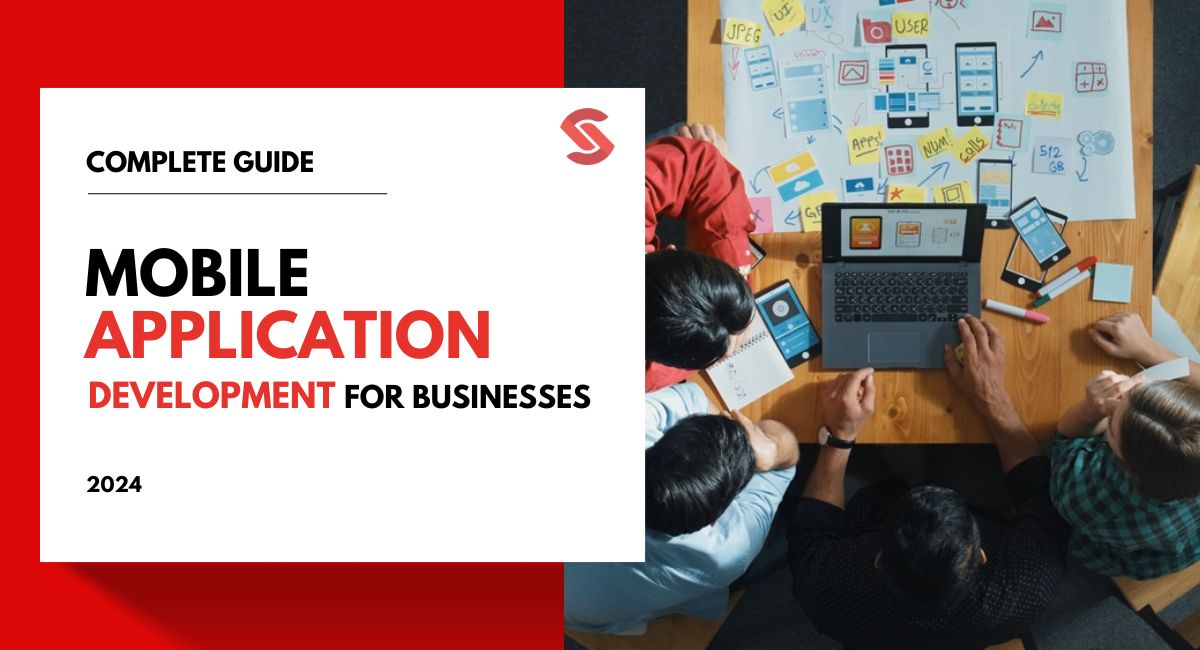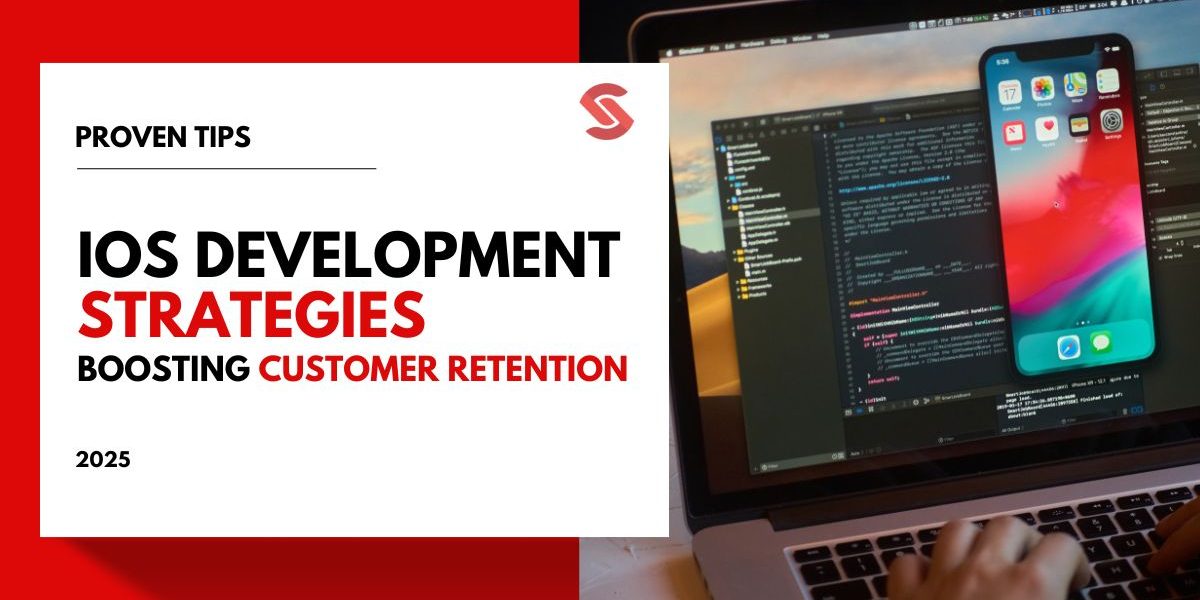Are you worried that your business might be falling behind because you don’t have a mobile app for your business?
In a world where people use apps for everything—shopping, banking, and staying connected—not having one could put your business at a disadvantage.
While your competitors are reaching customers directly through their mobile apps, your business might be missing out on those crucial opportunities.
According to Statista, in 2023, users downloaded 121 billion apps from the Google Play Store and 35 billion from the App Store, with these numbers projected to rise significantly by 2026.
These numbers are only going up. If your business isn’t part of this mobile revolution, you could be losing ground fast.
So, why should your business invest in mobile app development? It’s simple: having a mobile app isn’t just about staying competitive; it’s about driving growth and engaging with your customers in ways that weren’t possible before.
This guide will help you understand what mobile app development is and why it’s essential for your business.
You’ll learn how to develop a mobile application that’s secure, compliance-friendly, and tailored to your business needs. We’ll also explore different types of app development options, so you can choose the right path for your business. And to make sure you avoid common pitfalls, we’ll discuss what not to do in mobile app development.
Are you ready to take your business to the next level? Let’s begin.
What is Mobile App Development?
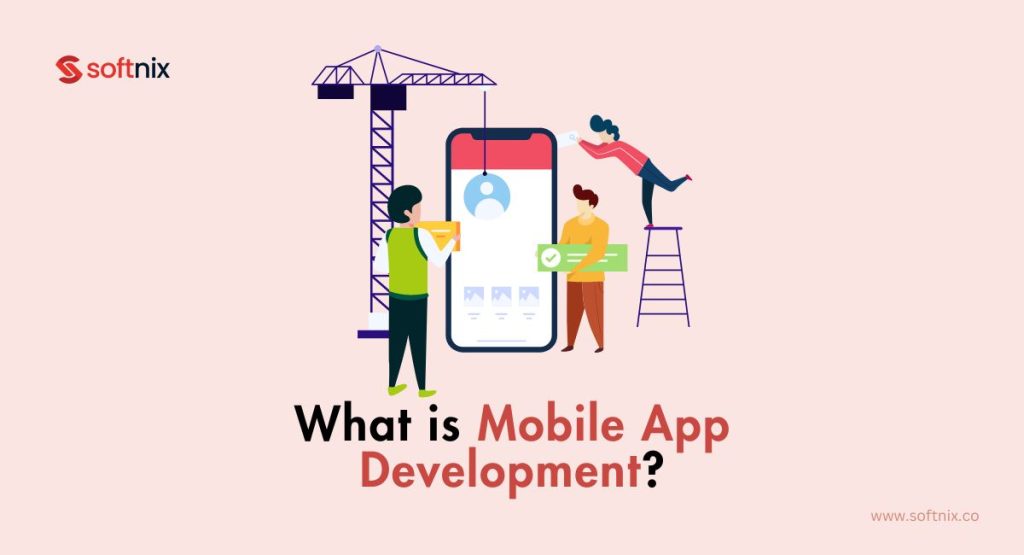
Mobile app development is the process of creating software for smartphones. These apps run on platforms like Android and iOS, which are the most common. Mobile app creation involves coding languages, designing user interfaces, and ensuring a smooth user experience.
As more people use smartphones, the importance of building mobile apps for businesses has grown. Historically, mobile apps started with simple functions but now offer complex services. Today, app stores are full of diverse apps, making mobile software development a key part of the tech market.
Why Businesses Should Invest in Mobile App Development Services
The benefit of investing in mobile app development services is that mobile apps boost customer value and brand strength by providing easy service access. They enhance customer engagement through push notifications and loyalty programs. Apps also give businesses a market advantage by increasing brand visibility and enabling personalized marketing. Analyzing user data helps refine marketing strategies, making mobile apps a smart investment for improving ROI.
1. Offer More Value to Your Customers
Mobile apps provide extra value to customers through features like rewards, discounts, and exclusive content. Loyalty programs encourage repeat purchases, while push notifications keep users informed about special offers. In-app purchases and personalized offers make users feel valued, boosting customer satisfaction and engagement. Collecting customer feedback helps refine these features, ensuring the app continues to meet users’ needs and enhance their experience.
2. Strengthen Your Brand
A mobile app enhances brand visibility and recognition, leading to stronger customer loyalty. Consistent design, including logo visibility and brand colors, reinforces your brand identity. According to branding expert Marty Neumeier, “A brand is not what you say it is, it’s what they say it is.” Mobile apps help shape positive perceptions by delivering consistent, branded experiences. App branding and messaging build trust, making customers more likely to engage with your brand and remain loyal.
3. Boost Customer Engagement
Mobile apps boost customer engagement through interactive features, timely push notifications, and personalized experiences. In-app messaging and gamification make the app more engaging, while personalized content ensures users feel valued. Analyzing engagement analytics helps refine these features to better meet user needs. Regular updates and interactive elements keep customers interested, promoting long-term engagement and satisfaction.
4. Gain an Advantage in Your Market
Mobile apps give businesses a competitive edge by offering unique features and improving customer service. They help differentiate your brand in a crowded market and attract more customers. Here are a few ways mobile apps can give you an advantage:
- Market differentiation: Stand out with innovative app features.
- Customer support: Provide quick, efficient service through the app.
- Competitor analysis: Use app data to understand and outperform competitors.
- Market positioning: Establish a strong presence with a dedicated mobile app.
Using these strategies, businesses can achieve significant growth and maintain a lead in their industry.
5. Create a Personalized Marketing Platform
Mobile apps allow for personalized marketing by analyzing user data and delivering targeted content. With data analytics, apps create user profiles that help in crafting personalized recommendations and ads. This targeted approach ensures that customers receive content and offers that match their preferences, increasing engagement and satisfaction.
How to Develop a Mobile Application for Business?
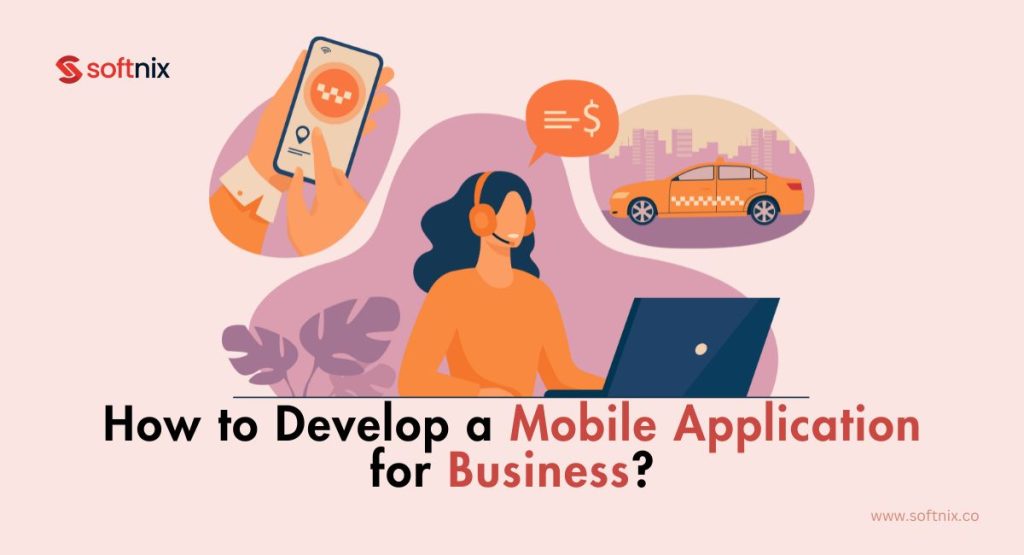
Developing a mobile app for business involves several steps. You can start development by identifying your business needs and target market. Conduct market research to understand customer preferences. Plan your app’s features and design, choosing the right technology stack. Follow development stages from coding to testing. Finally, launch your app and gather feedback for improvements. This structured approach ensures a successful app development process.
Step 1: Identifying Business Needs and Goals
Start by understanding your business needs and goals to align your app with business objectives. Conduct a needs assessment to pinpoint what your app must achieve. Set clear goals and define the project scope. Gather requirements through business analysis and project planning to ensure your app meets all necessary criteria. This foundational step guides the entire app development process, ensuring it aligns with your business strategy.
Step 2: Research the Target Market
Understanding your target market is crucial for developing a successful app. Conduct thorough market research to learn about competitors and customer demographics. Use the following tips to guide your research:
- Competitor analysis: Identify what similar apps offer and their weaknesses.
- Market trends: Keep up with industry trends to stay relevant.
- User surveys: Collect feedback directly from potential users.
- Demographic analysis: Understand the age, gender, and preferences of your audience.
- Customer personas: Create detailed profiles of your ideal users.
These insights help shape your app’s features and marketing strategy, ensuring it resonates with your target audience.
Step 3: Finalize Your App Features
Determine the essential features of your app based on user needs and business goals. Prioritize features that offer the most value to users. Gather user feedback to refine your feature list. Focus on essential functionalities that align with your business objectives. Feature prioritization and development should reflect what your users find most useful, ensuring a user-centered design that supports business growth.
Step 4: Planning and Strategy Development
Effective planning and strategy development ensure a smooth app creation process. Allocate resources, set timelines, and choose a development methodology like Agile. Outline project milestones to track progress. Proper planning helps manage resources efficiently and keeps the project on schedule. This strategic phase sets a clear roadmap, ensuring all team members understand their roles and responsibilities.
Step 5: Designing the App
Designing an effective and user-friendly app starts with UI/UX design principles. Create wireframes to outline the app’s structure, then develop prototypes for testing. Focus on a clean, intuitive user interface to enhance user experience. Use design tools for iterations, refining the design based on user feedback. A well-designed app attracts and retains users by offering a seamless experience.
Step 6: Choosing the Right Technology
Selecting the right technology stack is crucial for app development. Consider scalability and compatibility with different platforms. Choose appropriate programming languages, development frameworks, and backend and frontend technologies. Evaluate the tech stack to ensure it meets your app’s needs and can support future growth. The right technology stack ensures your app performs well and adapts to changing demands.
Step 7: App Development Phases
Developing an app involves several key phases, each crucial for a successful launch. Here are the main stages of app development:
- Coding: Writing the app’s code based on design specifications.
- Integration: Combining different modules to work together.
- Testing: Ensuring the app functions correctly.
- Deployment: Releasing the app to users.
Following these phases ensures a structured and efficient development process, leading to a well-functioning app.
Step 8: Testing and Quality Assurance
Testing and quality assurance ensure your app meets high standards before launch. This phase identifies and fixes bugs, enhancing the user experience. Key steps include defining test cases, using QA tools for both automated and manual testing, tracking and fixing bugs, and conducting usability tests to ensure the app is user-friendly. Thorough testing ensures the app is reliable and performs well.
Step 9: Launching the App
A successful app launch involves careful planning and execution. Marketing strategies, user onboarding, and post-launch support are crucial for a smooth rollout. Consider promoting your app through a launch campaign to reach your target audience, providing user tutorials to help users get started, gathering user feedback to improve the app, regularly updating the app to fix issues and add features, and optimizing the app store listing for better visibility.
Developing a Secure and Compliance-Friendly Mobile App for Business
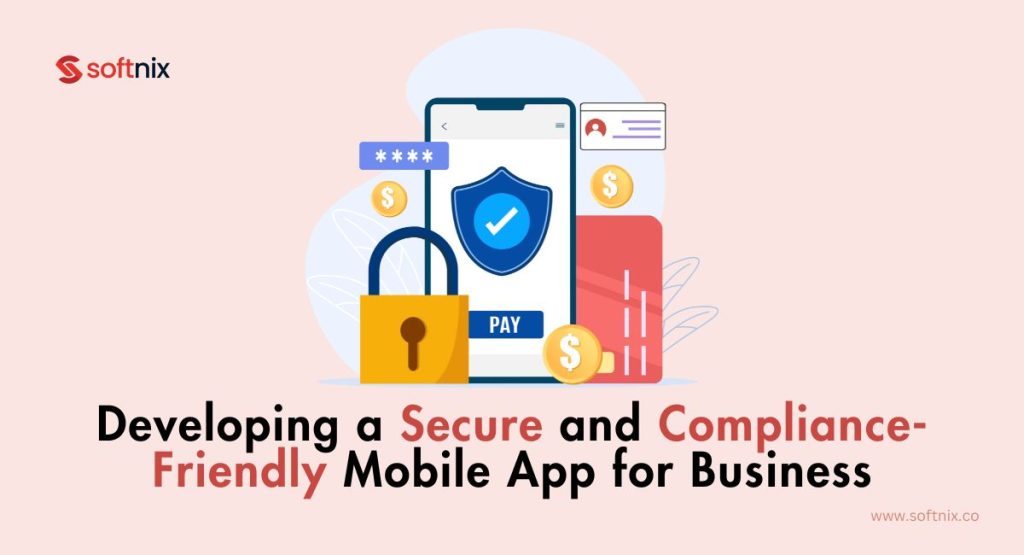
Ensuring security and compliance in mobile app development is important. Apps must follow industry standards and regulations to protect user data. Implement security protocols like data encryption and regular compliance checks. Adhering to regulatory frameworks ensures the app meets legal requirements and best practices. Secure app development builds trust with users and safeguards sensitive information, making it vital for business success.
PCI DSS (Payment Card Industry Data Security Standard)
Meeting PCI DSS requirements is key for any app that handles credit card payments. This standard ensures payment security and data protection, helping businesses avoid data breaches. Here are ways to implement PCI DSS in mobile app development:
- Secure transactions: Use secure payment gateways.
- Data encryption: Encrypt sensitive data during storage and transmission.
- Compliance checklist: Follow the PCI compliance checklist.
- Security audits: Conduct regular audits to ensure ongoing compliance.
Following PCI DSS guidelines helps protect credit card data and maintain customer trust.
GDPR (General Data Protection Regulation)
GDPR focuses on data privacy and protection for users in the EU. Ensuring compliance in mobile app development involves adhering to several principles. These steps help protect user data and ensure compliance with GDPR:
- User consent: Obtain clear user consent for data processing.
- Data processing: Handle data according to GDPR principles.
- User rights: Ensure users can access and delete their data.
- Data breach response: Have a plan for responding to data breaches.
HIPAA (Health Insurance Portability and Accountability Act)
HIPAA sets standards for protecting health information in the U.S. Mobile health apps must meet these requirements to ensure patient privacy and data security. Here’s how to achieve HIPAA compliance:
- PHI security: Secure Protected Health Information (PHI) at all times.
- Data encryption: Encrypt health data during storage and transmission.
- Patient consent: Obtain consent for data use and sharing.
- HIPAA rules: Follow all HIPAA rules and guidelines.
Complying with HIPAA helps protect patient privacy and builds trust in your health app.
CCPA (California Consumer Privacy Act)
CCPA grants California consumers rights over their data. Mobile apps must comply with CCPA to respect these rights. Here’s how to ensure CCPA compliance:
- Consumer rights: Allow users to access and delete their data.
- Privacy policy: Clearly outline data practices in your privacy policy.
- Data security measures: Implement strong security measures to protect data.
- Data access requests: Respond promptly to data access requests.
Following CCPA principles ensures your app respects consumer privacy and complies with state regulations.
Data Protection Standards for Mobile Application Development
Here is a table below that summarizes key data protection standards and their descriptions.
| Standard | Description |
|---|---|
| PCI DSS | The Payment Card Industry Data Security Standard is a set of security standards designed to ensure that all companies that accept, process, store or transmit credit card information maintain a secure environment. |
| GDPR | The General Data Protection Regulation is a regulation in EU law on data protection and privacy in the European Union and the European Economic Area. It also addresses the transfer of personal data outside the EU and EEA areas. |
| HIPAA | The Health Insurance Portability and Accountability Act is a United States legislation that provides data privacy and security provisions for safeguarding medical information. |
| CCPA | The California Consumer Privacy Act is a state statute intended to enhance privacy rights and consumer protection for residents of California, USA. |
Different Types of App Development Options for Businesses
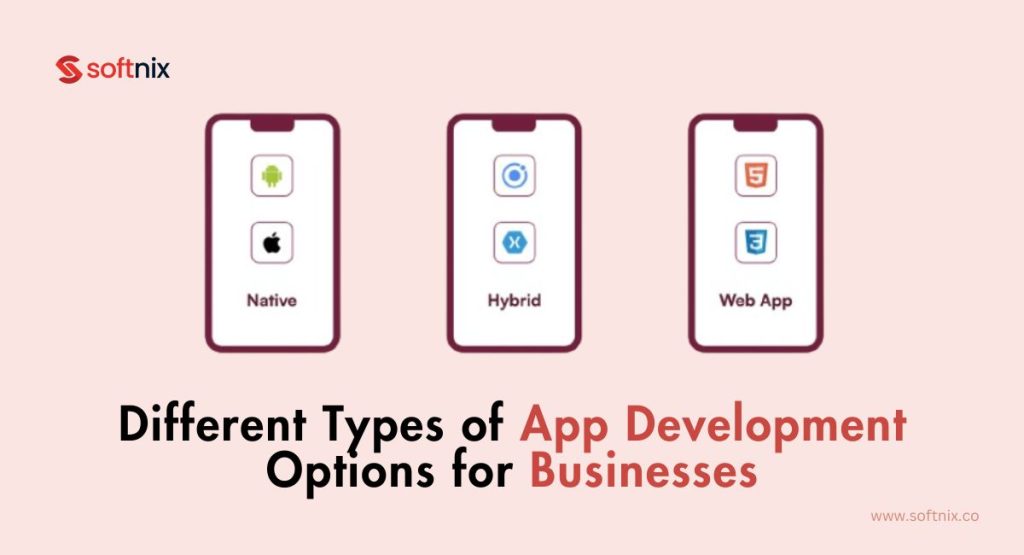
Businesses have several app development options to consider. Native apps offer high performance but are costly. Hybrid apps combine web and native elements, balancing cost and functionality. Cross-platform apps use a single codebase for multiple platforms. Progressive web apps (PWAs) provide a web-based experience with app-like features. Each option has unique benefits and trade-offs.
1. Native App Development
Native app development creates apps specifically for Android or iOS using platform-specific tools and languages. This approach offers high performance and a seamless user experience. Here are the pros and cons of native app development:
| Pros | Cons |
|---|---|
| Performance optimization: Native apps run smoothly and efficiently. | Higher costs: Developing separate apps for Android and iOS can be expensive. |
| User experience: Excellent UI/UX tailored to the platform. | Longer development time: Building and maintaining two codebases takes more time. |
| Platform-specific features: Access to all device features and functionalities. | Complex updates: Updates must be implemented separately for each platform. |
| Choosing native app development ensures top-notch performance and user satisfaction, but it requires more resources and time. |
2. Android App vs iOS App
Developing apps for Android and iOS involves different considerations. Android has a larger market share, but iOS users typically spend more on apps. Here are key comparisons:
Market share:
- Android: Larger global user base.
- iOS: Higher spending users.
User demographics:
- Android: More varied in age and income.
- iOS: Often younger, higher-income users.
Development complexity:
- Android: More device variations, can complicate development.
- iOS: Fewer devices, simpler but strict app store guidelines.
Understanding these differences helps in making informed decisions on which platform to target first.
3. Hybrid Apps
Hybrid apps combine elements of both native and web apps. They offer benefits like faster development and cost-effectiveness but come with some trade-offs. Here are the pros and cons:
| Pros | Cons |
|---|---|
| Cost-effectiveness: One codebase for multiple platforms | Performance trade-offs: May not be as fast or smooth as native apps |
| Development speed: Faster to build and deploy | User experience: Can feel less polished compared to native apps |
| Platform compatibility: Works across different devices | Limited access: Not all native device features are accessible |
Hybrid apps are suitable for businesses needing a presence on multiple platforms quickly and affordably.
4. Cross-Platform Apps
Cross-platform apps use a single codebase for multiple platforms, offering several advantages. Here are the benefits and considerations:
| Pros | Cons |
|---|---|
| Development efficiency: Faster development with a single codebase. | Performance considerations: This may not match native apps in speed and smoothness. |
| Cost savings: Lower costs compared to developing separate native apps. | Platform consistency: Ensuring a consistent look and feel across platforms can be challenging. |
| User reach: Broader audience across platforms. | Codebase limitations: Not all features of each platform may be supported. |
Cross-platform development is ideal for businesses aiming to reach users on both Android and iOS without high costs.
5. Progressive Web Apps (PWAs)
Progressive Web Apps (PWAs) blend the best of web and mobile apps, offering several advantages. Here are the key benefits:
| Pros | Cons |
|---|---|
| Offline functionality: Works even without an internet connection. | Limited access: Some device features might not be available. |
| Performance: Fast loading times and smooth performance. | Browser dependency: Performance can vary across different browsers. |
| Cost-effectiveness: Lower development costs compared to native apps. | App store visibility: Not listed in app stores, which can reduce discoverability. |
PWAs are great for businesses looking to provide a seamless web experience with app-like features and lower costs.
Comparison of App Development Types
The table below outlines various app development types, their technologies, costs, and the best-suited businesses for each type.
| Type of App Development | Technology | Cost | Best For |
|---|---|---|---|
| Native App Development | Uses platform-specific languages (Java/Kotlin for Android, Swift/Objective-C for iOS) | High | Businesses needing high performance and custom functionality |
| Android App vs. iOS App | Android: Java/Kotlin, iOS: Swift/Objective-C | Varies based on platform | Businesses targeting specific platforms or user demographics |
| Hybrid Apps | Combines web technologies (HTML, CSS, JavaScript) with native features using frameworks like Ionic, Cordova | Moderate | Businesses need a faster and more cost-effective way to deploy on multiple platforms |
| Cross-Platform Apps | Uses frameworks like React Native, Flutter to write a single codebase for multiple platforms | Moderate to High | Businesses wanting to maintain a single codebase for both Android and iOS |
| Progressive Web Apps (PWAs) | Built with standard web technologies (HTML, CSS, JavaScript) | Low | Businesses looking for a cost-effective way to reach users across multiple platforms with a single app |
Key Mobile App Development Trends for Businesses to Watch
As mobile apps become more vital for businesses, keeping up with the latest trends is crucial. Businesses should keep an eye on several emerging trends in mobile app development.
These include the integration of artificial intelligence for smarter apps, the use of 5G technology for faster and more reliable connectivity, and cloud computing for scalable services. The Internet of Things (IoT) connects smart devices, while AR/VR enhances user experiences. Blockchain ensures secure and transparent transactions. Staying updated with these trends can provide a competitive edge.
1. Increased Focus on Artificial Intelligence (AI) and Machine Learning (ML)
AI and ML are transforming mobile apps by enhancing functionality and user experience. These technologies enable predictive analytics, personalization, and chatbot integration. Apps like Google Assistant and Netflix use AI algorithms and ML models to deliver personalized experiences and intelligent recommendations. AI-driven analytics also help apps adapt to user behavior, making them more intuitive and efficient.
2. Rise of 5G Technology
5G technology is revolutionizing mobile apps with faster speeds and enhanced capabilities. This high-speed connectivity allows for real-time data transfer and low latency. Apps like augmented reality (AR) games and live streaming services benefit from 5G-enabled features. For example, apps like Pokémon Go and Twitch leverage 5G to provide smoother, more interactive experiences, improving overall app performance and user satisfaction.
3. Cloud Computing
Integrating cloud computing with mobile apps offers scalability and efficient data storage. Cloud-based apps like Dropbox and Google Drive provide seamless data synchronization and access to remote servers. This integration enhances app performance by offloading data storage and processing to the cloud. Scalability solutions ensure that apps can handle increasing user demands without compromising speed or reliability.
4. Internet of Things (IoT) Enabled Mobile Apps
IoT integration in mobile apps connects devices for enhanced functionality and automation. These apps use IoT sensors for real-time data and device connectivity. Examples include smart home apps like Google Home and wearable device apps like Fitbit. These smart apps allow users to control home devices, monitor health metrics, and improve efficiency. IoT-enabled applications bring automation and convenience to daily tasks.
5. Adoption of Augmented Reality (AR) and Virtual Reality (VR)
AR and VR are transforming mobile apps by creating immersive experiences. AR tools and VR environments offer interactive designs that enhance user interaction. Apps like Pokémon Go use AR for gaming, while VR apps like Google Cardboard provide virtual tours. According to Tim Cook, Apple CEO, “AR will change everything.” These technologies offer innovative ways to engage users and create unique app experiences.
6. Blockchain Technology
Blockchain technology in mobile apps enhances security and transparency through decentralized systems. These apps use blockchain protocols and smart contracts for secure transactions and data integrity. Examples include cryptocurrency wallets like Coinbase and secure messaging apps like Telegram. Blockchain integration ensures that data is tamper-proof and transactions are transparent, making apps more trustworthy and secure. This technology is key for secure app development and managing sensitive information.
What Not to Do: Avoiding Mistakes in Mobile App Development
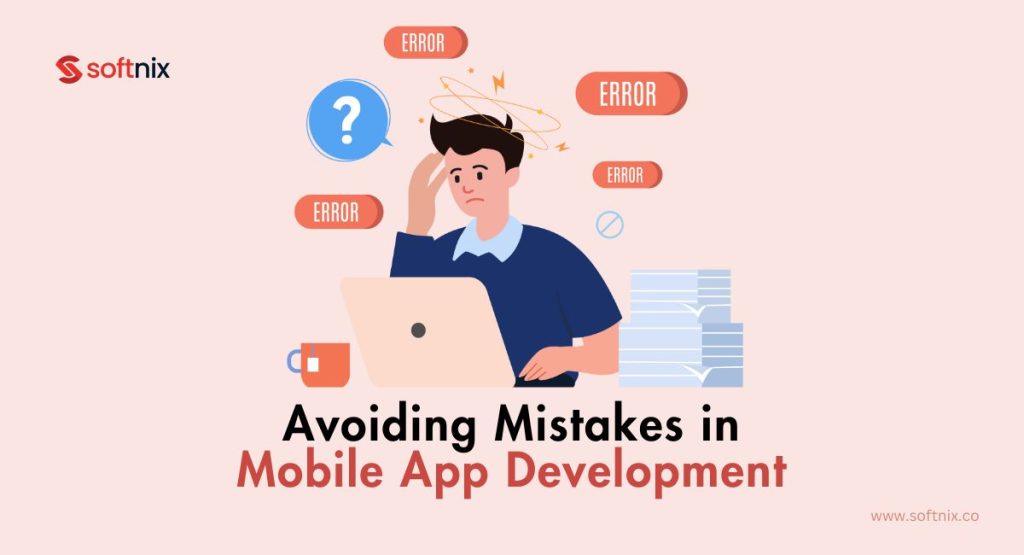
Avoid common mistakes in mobile app development by focusing on user feedback, UI/UX design, and security. Skipping usability testing can lead to poor user experiences. Ignoring design principles may cause UI/UX flaws. Neglecting security measures puts data at risk. Prioritize essential features and develop a minimum viable product (MVP) to test and refine. Avoiding these errors ensures a successful app.
1. Ignoring User Feedback and Testing
Not considering user feedback and skipping testing can lead to app failure. Effective testing ensures the app performs well and meets user needs. When developers ignore these critical steps, the consequences can be severe, including:
- App performance issues: Unresolved bugs and crashes that frustrate users.
- User dissatisfaction: A poor user experience leads to negative reviews and low ratings.
- Missed improvements: Lack of feedback prevents the identification of necessary enhancements.
Listening to users and conducting thorough testing is essential for creating a successful, user-friendly app that meets expectations and performs reliably.
2. Overlooking the Importance of UI/UX Design
UI/UX design plays a critical role in user satisfaction and app success. Following design best practices ensures a smooth, enjoyable user experience, which boosts engagement, satisfaction, and overall app success. Ignoring this aspect can have significant negative impacts, such as:
- Confusing interface: Users struggle to navigate the app, leading to frustration.
- Poor user experience: An unappealing and hard-to-use app leads to low engagement and retention.
- Negative perception: Aesthetically unpleasing design can deter users and damage the app’s reputation.
3. Neglecting App Security and Data Privacy
Neglecting security and data privacy puts user data at risk and can severely damage your app’s reputation. The potential risks include:
- Security breaches: Hackers exploit vulnerabilities to steal sensitive information.
- User distrust: Users avoid apps that fail to protect their data, leading to a loss of user base.
- Legal issues: Non-compliance with data protection laws can result in significant fines and penalties.
Implementing robust security measures, such as encryption and secure coding practices, safeguards user data, maintaining trust and compliance with regulatory requirements.
4. Overloading the App with Unnecessary Features
Adding too many features can overwhelm users and degrade app performance. Prioritizing essential features and focusing on simplicity enhances usability and user satisfaction, ensuring that the app remains efficient and easy to use. This can result in various problems, including:
- Complex usability: Users find the app confusing and difficult to navigate.
- Slower performance: Extra features can slow down the app, affecting user experience.
- High development costs: More features mean higher development and maintenance costs.
5. Adding Too Many Features
Focusing on essential features and trimming unnecessary ones improves app performance, usability, and overall user satisfaction, leading to a more successful app. Adding excessive features can negatively impact app performance and user satisfaction. This often results in:
- Feature bloat: Unnecessary features clutter the app, making it cumbersome.
- Decreased app speed: Too many features can significantly slow down performance.
- User frustration: Users get overwhelmed by the app’s complexity and may abandon it.
6. Not Considering Making an MVP
Creating an MVP allows for iterative development, reducing risks and ensuring the app meets user expectations and market demands. This approach helps in making informed decisions based on real user feedback. Developing a Minimum Viable Product (MVP) helps test market response and gather feedback. Skipping this crucial step can lead to several issues:
- High initial costs: Developing a full-featured app without validation can be expensive and risky.
- Missed feedback: Without an MVP, developers miss out on valuable user input that could guide improvements.
- Market misfit: The product may not meet market needs, resulting in poor adoption and failure.
Choosing the Right Partner for Your App Development Need
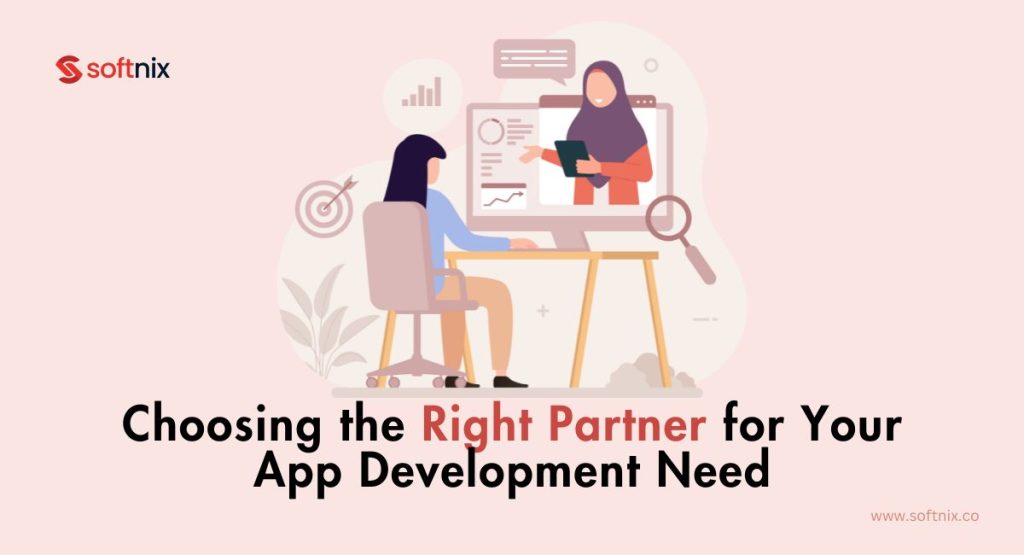
Finding the right partner for your app development project is vital for success. Start by evaluating their expertise and checking their portfolio to see if they have experience in your industry. Effective communication and collaboration are essential, so choose a partner with strong project management skills and the right tools.
Look for reviews and testimonials to gauge their reliability and past performance. A good fit ensures a smooth workflow and a successful app. By doing thorough research and considering these factors, you can find a partner that meets your needs and helps bring your app vision to life.
How to Hire a Mobile App Development Company?
The right way to hire a mobile app development company involves several important steps. First, set clear criteria based on your project needs, including expertise, experience, and budget. Conduct thorough interviews to assess their skills and compatibility. Review their portfolio to see their past work and check references to verify their reliability. Here are some questions to ask before hiring:
- What is your experience in developing similar apps?
- Can you provide references or case studies?
- What development process do you follow?
- How do you handle project management and communication?
- What are your payment terms and contract details?
After gathering this information, negotiate the contract terms. This ensures you hire a company that meets your needs and can deliver a successful app. Doing this research upfront helps in making an informed decision.
Understanding the Cost of Mobile App Development
Understanding the cost of mobile app development involves considering several factors. The complexity of the app, the number of features, and the development time significantly impact the budget.
According to Clutch, a simple app can cost between $30,000 to $70,000, while more complex apps range from $70,000 to $150,000 or more. Additional factors include the development team’s location, the need for integrations, and post-launch support.
Cost estimation, feature analysis, and budget planning are essential. Planning your budget and timeline helps in managing these costs effectively and ensures a cost-effective app development process that meets your needs. Proper understanding and planning prevent overspending and help achieve the desired app functionality within budget constraints.
How Softnix Can Help in Your App Development Endeavors

Softnix can support your app development journey with expertise and comprehensive services. Our experienced team excels in creating tailored solutions that meet your business needs. We offer a range of services from initial concept to final deployment, ensuring a smooth development process. Our project portfolio showcases numerous success stories and satisfied clients.
With Softnix, you gain access to a dedicated team committed to delivering high-quality, functional, and user-friendly apps that drive business growth and success.
FAQs about Mobile App Development
1. What are the key steps in mobile app development?
The key steps in mobile app development include identifying business needs, researching the target market, finalizing app features, planning, and strategy development, designing the app, choosing the right technology stack, development phases, testing, and quality assurance, and launching the app. Each step is crucial for ensuring a successful and user-friendly app.
2. How long does it take to develop a mobile app?
The development time for a mobile app varies based on complexity, features, and the development process. A simple app may take 3-4 months, while a more complex app can take 6-12 months or longer. Proper planning, clear requirements, and an experienced development team can help streamline the process.
3. What factors influence the cost of mobile app development?
Several factors influence the cost of mobile app development, including app complexity, number of features, development time, team location, and post-launch support. Additional costs may include integrations with third-party services and ongoing maintenance. Proper budgeting and planning help manage costs effectively.
4. Why is user feedback important in app development?
User feedback is crucial in app development as it helps identify bugs, improve functionality, and enhance user experience. Regular testing and gathering feedback from beta users ensure the app meets user needs and expectations. Ignoring user feedback can lead to poor app performance and low user satisfaction.
5. What are the benefits of developing a Minimum Viable Product (MVP)?
Developing an MVP allows businesses to test market response with a basic version of the app. This approach helps gather user feedback, make necessary improvements, and validate the app idea without incurring high initial costs. An MVP reduces risks and ensures the final product meets market demands.
6. How does Softnix support app development projects?
Softnix supports app development projects by offering comprehensive services from concept to deployment. Our experienced team provides expertise in design, development, and testing. We ensure a smooth development process and deliver high-quality, user-friendly apps. Our portfolio and client testimonials highlight our successful projects and client satisfaction.
7. What is the difference between native and hybrid apps?
Native apps are built specifically for a single platform (iOS or Android) using platform-specific languages, offering high performance and full access to device features. Hybrid apps, on the other hand, use web technologies and run on multiple platforms with a single codebase, offering faster development and lower costs but potentially lower performance.
8. How important is UI/UX design in mobile app development?
UI/UX design is vital in mobile app development as it directly impacts user satisfaction and engagement. A well-designed app with an intuitive interface and smooth user experience attracts and retains users. Poor UI/UX can lead to frustration, low engagement, and negative reviews, affecting the app’s success.
9. What security measures should be implemented in mobile apps?
Implementing security measures such as data encryption, secure coding practices, and regular security audits is crucial for protecting user data. Additionally, apps should have strong authentication mechanisms, secure data storage, and compliance with data protection regulations like GDPR and HIPAA to ensure user trust and legal compliance.
10. How do IoT-enabled mobile apps work?
IoT-enabled mobile apps connect with IoT devices to collect and process real-time data. These apps use IoT sensors and platforms to enable functionalities like remote control, automation, and monitoring. Examples include smart home apps like Google Home, which allow users to control devices like lights and thermostats through their smartphones.
11. What are the advantages of using AR and VR in mobile apps?
AR and VR technologies create immersive and interactive experiences in mobile apps. AR apps like Pokémon Go enhance the real world with digital overlays, while VR apps like Google Cardboard offer virtual tours and simulations. These technologies engage users, provide unique experiences, and can be used in various industries like gaming, education, and real estate.
12. Why should businesses consider cloud computing for mobile apps?
Cloud computing offers scalability, efficient data storage, and enhanced performance for mobile apps. Cloud-based apps like Dropbox provide seamless data synchronization and access to remote servers. Integrating cloud services reduces infrastructure costs, improves app reliability, and allows for easy updates and maintenance, making it an ideal choice for modern app development.

